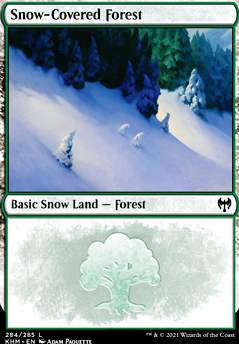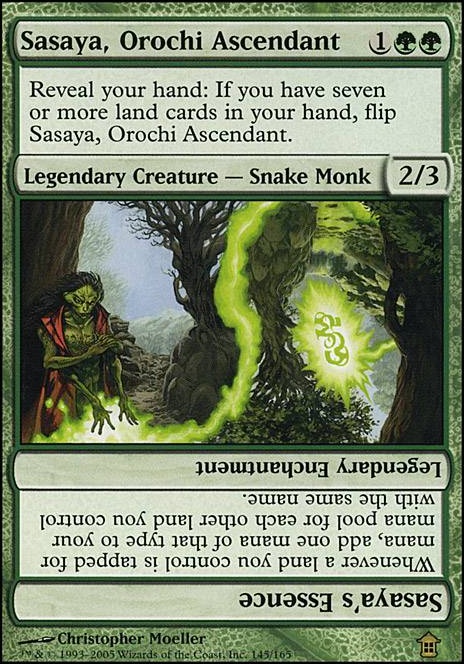This won't be too much of a primer because I don't believe the deck is optimized to its fullest in its current state (I'm always making improvements, plus I don't believe anything faster than a turn 5 kill is even feasible (and even that would be rare)), but in general the deck plays something like this:
The Mulligan
Obviously given the nature of the commander going down to six or below is going to be even more painful than normal, so with a deck that's literally over fifty percent lands many opening sevens can be tempting "good enough" keeps. Lands and spells, right? Even six-land hands can entice because of Sasaya's flip condition. The thickest point on this deck's curve is at three, so what you want to be looking for, then, are things to be doing on turn two. Even if that's just cycling a land, anything that uses that mana. The three drops to look for should be a bit more obvious -- things that find lands -- and then, at the bottom of the priority list, are the payoffs. Obviously, not every hand or draw is going to be perfect, but this is a good starting point.
Play
As perhaps implied by the above, there isn't much to do on turn one, and turn two only has a few options. Turn three should be on-curve, playing a creature or spell to find more lands. What you want to be setting up are opportunities to draw multiple cards or find multiple lands at once, preferably at instant speed. The turn before going off will likely involve two such activations so you want the permanents in play now. Like most decks, mana efficiency is key; turns four and five are much easier in that regard, though playing a three-drop on turn four isn't the end of the world.
The way we get around the hand size limit with relation to Sasaya's flip trigger is with those aforementioned instant-speed effects; you want to be going into the combo turn with a nine-or-ten card hand if you can help it. Draw a card, play Sasaya, play a land, and go off to the races.
The deck has a few win conditions.
Wakeroot Elemental
is the most obvious, though
Finale of Devastation
can also serve that with its overrun effect. The primary method of attaining these is
Genesis Wave
for all the mana. Most of the remaining cards are designed to get to that point. Cards like
Nantuko Cultivator
draw cards,
Planar Portal
,
Ring of Three Wishes
et al. are tutors -- expensive tutors, sure, but hey,
Azusa, Lost but Seeking
and her kin mean that you can manage even more mana in that critical turn.
There are flaws in this plan, of course. Wakeroot Elemental aside, the mana is not infinite like other combos, so fizzling out can happen. Discard is obviously a problem -- you can't have seven lands in hand if you don't have seven cards -- and there are enough artifacts flying around that disruption at that angle is effective as well. But there is something to be said for Genesis Wave-ing the entire deck and swinging in with a horde of lands, and I just have to love it.
Cards Notably Absent
The most notable cuts according to EDHRec are
Seek the Horizon
,
Gaea's Bounty
,
Nissa's Triumph
, and
Nylea's Intervention
. These are all cards I dislike in a combo-focused version of the deck for the same reason: they're sorcery-speed and they clog up the hand size --
Seek the Horizon
especially. This deck used to have
Reliquary Tower
along with some dedicated tutors in
Expedition Map
and
Sylvan Scrying
to offset this issue, but I eventually found that just getting a bunch of lands at instant speed was a more comfortable play pattern than trying to dig for a land that is otherwise useless on the combo turn.
Another common category of cards I cut down on is ramp effects.
Cultivate
and
Kodama's Reach
especially show up in many Sasaya lists and I admit, I've never really been convinced of their efficacy. They're not plus on lands like Gaea's Bounty et al., ramp isn't exactly the main gameplan (until it suddenly is), so on the whole, I find they're a waste of a turn three. I've seen some lists play
Peregrination
as well, which is even worse. Nissa's Pilgrimmage survives because very occasionally it has upside (which is significant when it happens), but even its spot is constantly in question and I could see cutting it if something more enticing comes along.
This leads rather nicely into the next batch of cards I don't think belong in this version of the deck: cards that replace themselves with lands in hand like
Wanderer's Twig
and
Sylvan Ranger
. Like the ramp spells, the fact that they don't increase one's hand size is my biggest strike against these cards. In all cases I would rather skip paying mana and just draw the land myself. And again, better versions of these effects do exist in my list.
Evolution Charm
can act as a regrowth effect,
Jadelight Ranger
has a chance to pull two lands, even using a creature tutor to find
Dryad Arbor
technically counts. The effect is not absent in this deck, these are just the best versions of that effect.
Last on my list to address are the incremental artifacts,
Journeyer's Kite
,
Thaumatic Compass
, and, to a lesser extent,
Scroll of Origins
. These cards were great, but they weren't "make the list" great, if that makes sense. As I continued to tune and play with the deck, I noticed that they weren't getting as many activations as I would have liked. I only seemed to be activating them once per game -- obviously not where I want cards like this to be. I admit, I don't remember what they were specifically cut for (though
Endless Atlas
sticks around in their memory), but it was still sad to see them go.
I hope that answers the most common questions about the deck. I do have reasons for including or not including most of the other cards on the EDHRec page, but if I kept going, this section would never end, so if you do have a question, feel free to ask and I'll put my thoughts down in the comments. Thanks for reading, and I hope you enjoy the deck!
-r


